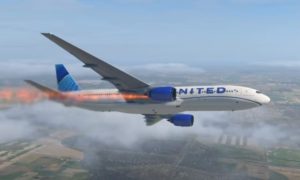 Image: Bull Bosphorus
Image: Bull Bosphorus
A United Airlines Boeing 777 engine on Fire
What is the best way for a pilot to deal with an engine fire?
Engine fire is a very rare occurrence in modern planes today. Nevertheless, it did happen on a Boeing 777 in Denver last year.
The best way for a pilot to deal with this is to immediately carry out the emergency fire drills by shutting down the correct engine, cutting off its fuel and electrical supply, then activate the fire extinguisher.
Studies have shown that a flight crew may have as few as 15 to 20 minutes to get a plane onto the ground after a fire is detected.
Inflight fire can also develop inside the cargo compartment, galley or lavatory area of the plane.
On 23 April, 2013, a Singapore Airlines Airbus A330 from Singapore to Dhaka with 105 passengers and 12 crew experienced a cargo fire whilst flying at 35,000 feet. They decided to divert to the nearest airport at Bangkok and landed safely within 20 minutes.
The captain did a great job because that was the safest and fastest way to handle a fire emergency.
On September 2 1998, a Swissair MD-11, Flight 111. crashed off the coast of Nova Scotia in Canada. The crash was due to faulty electrical wires which caused the plane’s flammable insulation to catch fire.
The captain should have headed directly to the runway. Instead, he wanted to dump fuel as the plane was above the maximum landing weight. By doing so, valuable time was probably wasted and 229 people lost their lives.
Surprisingly, Swissair asserted that the captain could not have managed a steep, fast, overweight and straight-in emergency landing.
On February 20, 2021, a United Airlines Boeing 777 (see videos below) on a scheduled flight from Denver to Honolulu suffered an engine failure four minutes after take-off. It then resulted in an in-flight engine fire.
The crew shut down the failed engine and returned to Denver on the remaining engine. The plane landed without further incident 24 minutes after take-off. There were no reported injuries to persons onboard or on the ground.
Pilots have been trained to treat any fire on the plane as a critical emergency. Therefore, they must land the stricken plane immediately.
Tests have shown that a fire can spread rapidly and become uncontrollable in just 8 to10 minutes. The average time for a crew to get their aircraft onto the ground was around 17 minutes.
To answer the question, the best way for an airplane pilot to deal with an engine fire is to follow the basic pilot’s mantra, ‘Aviate, Navigate, Communicate’,
Aviate – Fly the plane and keep it under control as detailed above.
Navigate – Divert to the nearest airport and without delay, point the nose towards the airport.
Communicate – A MAYDAY call be made for immediate air traffic control assistance. Additionally, keep the crew, customers and company informed too.
That would have saved the day as the United Airline captain did at Denver Airport, saving 241 lives!
View YouTube video Hawaii couple recounts harrowing moments after United flight 328 engine explosion
here https://www.youtube.com/watch?v=5Nbgs4Fm5lw
View another YouTube video United Airlines B777 Flight UA328 engine catches fire at Denver Airport – Emergency Landing